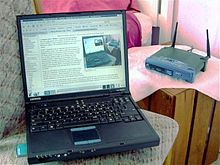
Back 802.11 Afrikaans آي تربل إي 802.11 Arabic IEEE 802.11 Bashkir IEEE 802.11 Bulgarian আইইইই ৮০২.১১ Bengali/Bangla IEEE 802.11 Catalan IEEE 802.11 Czech IEEE 802.11 Danish IEEE 802.11 German IEEE 802.11 Greek


IEEE 802.11 is part of the IEEE 802 set of local area network (LAN) technical standards, and specifies the set of medium access control (MAC) and physical layer (PHY) protocols for implementing wireless local area network (WLAN) computer communication. The standard and amendments provide the basis for wireless network products using the Wi-Fi brand and are the world's most widely used wireless computer networking standards. IEEE 802.11 is used in most home and office networks to allow laptops, printers, smartphones, and other devices to communicate with each other and access the Internet without connecting wires. IEEE 802.11 is also a basis for vehicle-based communication networks with IEEE 802.11p.
The standards are created and maintained by the Institute of Electrical and Electronics Engineers (IEEE) LAN/MAN Standards Committee (IEEE 802). The base version of the standard was released in 1997 and has had subsequent amendments. While each amendment is officially revoked when it is incorporated in the latest version of the standard, the corporate world tends to market to the revisions because they concisely denote the capabilities of their products. As a result, in the marketplace, each revision tends to become its own standard. 802.11x is a shorthand for "any version of 802.11", to avoid confusion with "802.11" used specifically for the original 1997 version.
IEEE 802.11 uses various frequencies including, but not limited to, 2.4 GHz, 5 GHz, 6 GHz, and 60 GHz frequency bands. Although IEEE 802.11 specifications list channels that might be used, the allowed radio frequency spectrum availability varies significantly by regulatory domain.
The protocols are typically used in conjunction with IEEE 802.2, and are designed to interwork seamlessly with Ethernet, and are very often used to carry Internet Protocol traffic.
| Generation | IEEE standard |
Adopted | Maximum link rate (Mb/s) |
Radio frequency (GHz) |
|---|---|---|---|---|
| (Wi-Fi 0*) | 802.11 | 1997 | 1–2 | 2.4 |
| (Wi-Fi 1*) | 802.11b | 1999 | 1–11 | 2.4 |
| (Wi-Fi 2*) | 802.11a | 1999 | 6–54 | 5 |
| (Wi-Fi 3*) | 802.11g | 2003 | 2.4 | |
| Wi-Fi 4 | 802.11n | 2009 | 6.5–600 | 2.4, 5 |
| Wi-Fi 5 | 802.11ac | 2013 | 6.5–6933 | 5[a] |
| Wi-Fi 6 | 802.11ax | 2021 | 0.4–9608[1] | 2.4, 5 |
| Wi-Fi 6E | 2.4, 5, 6[b] | |||
| Wi-Fi 7 | 802.11be | 2024[c] | 0.4–23,059 | 2.4, 5, 6[2] |
| Wi-Fi 8 | 802.11bn | exp. 2028[3] | 100,000[4] | 2.4, 5, 6[5] |
| *Wi‑Fi 0, 1, 2, and 3 are named by retroactive inference. They do not exist in the official nomenclature.[6][7][8] | ||||
Cite error: There are <ref group=lower-alpha> tags or {{efn}} templates on this page, but the references will not show without a {{reflist|group=lower-alpha}} template or {{notelist}} template (see the help page).
- ^ "MCS table (updated with 80211ax data rates)". semfionetworks.com.
- ^ "Understanding Wi-Fi 4/5/6/6E/7". wiisfi.com.
- ^ Reshef, Ehud; Cordeiro, Carlos (2023). "Future Directions for Wi-Fi 8 and Beyond". IEEE Communications Magazine. 60 (10). IEEE. doi:10.1109/MCOM.003.2200037. Retrieved 21 May 2024.
- ^ "What is Wi-Fi 8?". everythingrf.com. 25 March 2023. Retrieved 21 January 2024.
- ^ Giordano, Lorenzo; Geraci, Giovanni; Carrascosa, Marc; Bellalta, Boris (21 November 2023). "What Will Wi-Fi 8 Be? A Primer on IEEE 802.11bn Ultra High Reliability". arXiv:2303.10442.
- ^ Kastrenakes, Jacob (3 October 2018). "Wi-Fi Now Has Version Numbers, and Wi-Fi 6 Comes Out Next Year". The Verge. Retrieved 2 May 2019.
- ^ Phillips, Gavin (18 January 2021). "The Most Common Wi-Fi Standards and Types, Explained". MUO - Make Use Of. Archived from the original on 11 November 2021. Retrieved 9 November 2021.
- ^ "Wi-Fi Generation Numbering". ElectronicsNotes. Archived from the original on 11 November 2021. Retrieved 10 November 2021.